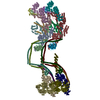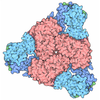[English] 日本語
 Yorodumi
Yorodumi- PDB-8bd7: IFTB1 subcomplex of anterograde Intraflagellar transport trains (... -
+ Open data
Open data
- Basic information
Basic information
| Entry | Database: PDB / ID: 8bd7 | |||||||||
|---|---|---|---|---|---|---|---|---|---|---|
| Title | IFTB1 subcomplex of anterograde Intraflagellar transport trains (Chlamydomonas reinhardtii) | |||||||||
 Components Components |
| |||||||||
 Keywords Keywords | PROTEIN TRANSPORT / Cilia / IFT / Intraflagellar / transport | |||||||||
| Function / homology |  Function and homology information Function and homology informationintraciliary transport particle / intraciliary transport particle B binding / intraciliary transport involved in cilium assembly / intraciliary transport particle B / system development / outer dynein arm assembly / cilium-dependent cell motility / intraciliary transport / regulation of cilium assembly / animal organ development ...intraciliary transport particle / intraciliary transport particle B binding / intraciliary transport involved in cilium assembly / intraciliary transport particle B / system development / outer dynein arm assembly / cilium-dependent cell motility / intraciliary transport / regulation of cilium assembly / animal organ development / axoneme assembly / axonemal microtubule / cilium organization / protein localization to cilium / non-motile cilium assembly / non-motile cilium / motile cilium / ciliary membrane / post-transcriptional regulation of gene expression / ciliary base / microtubule organizing center / cilium assembly / axoneme / kinesin binding / beta-tubulin binding / centriole / tubulin binding / regulation of microtubule cytoskeleton organization / regulation of protein stability / apical part of cell / protein transport / microtubule binding / cytoskeleton / protein stabilization / cilium / ciliary basal body / cytoplasm Similarity search - Function | |||||||||
| Biological species |  | |||||||||
| Method | ELECTRON MICROSCOPY / subtomogram averaging / cryo EM / Resolution: 9.9 Å | |||||||||
 Authors Authors | Lacey, S.E. / Foster, H.E. / Pigino, G. | |||||||||
| Funding support | European Union,  Italy, 2items Italy, 2items
| |||||||||
 Citation Citation |  Journal: Nat Struct Mol Biol / Year: 2023 Journal: Nat Struct Mol Biol / Year: 2023Title: The molecular structure of IFT-A and IFT-B in anterograde intraflagellar transport trains. Authors: Samuel E Lacey / Helen E Foster / Gaia Pigino /  Abstract: Anterograde intraflagellar transport (IFT) trains are essential for cilia assembly and maintenance. These trains are formed of 22 IFT-A and IFT-B proteins that link structural and signaling cargos to ...Anterograde intraflagellar transport (IFT) trains are essential for cilia assembly and maintenance. These trains are formed of 22 IFT-A and IFT-B proteins that link structural and signaling cargos to microtubule motors for import into cilia. It remains unknown how the IFT-A/-B proteins are arranged into complexes and how these complexes polymerize into functional trains. Here we use in situ cryo-electron tomography of Chlamydomonas reinhardtii cilia and AlphaFold2 protein structure predictions to generate a molecular model of the entire anterograde train. We show how the conformations of both IFT-A and IFT-B are dependent on lateral interactions with neighboring repeats, suggesting that polymerization is required to cooperatively stabilize the complexes. Following three-dimensional classification, we reveal how IFT-B extends two flexible tethers to maintain a connection with IFT-A that can withstand the mechanical stresses present in actively beating cilia. Overall, our findings provide a framework for understanding the fundamental processes that govern cilia assembly. | |||||||||
| History |
|
- Structure visualization
Structure visualization
| Structure viewer | Molecule:  Molmil Molmil Jmol/JSmol Jmol/JSmol |
|---|
- Downloads & links
Downloads & links
- Download
Download
| PDBx/mmCIF format |  8bd7.cif.gz 8bd7.cif.gz | 1.9 MB | Display |  PDBx/mmCIF format PDBx/mmCIF format |
|---|---|---|---|---|
| PDB format |  pdb8bd7.ent.gz pdb8bd7.ent.gz | Display |  PDB format PDB format | |
| PDBx/mmJSON format |  8bd7.json.gz 8bd7.json.gz | Tree view |  PDBx/mmJSON format PDBx/mmJSON format | |
| Others |  Other downloads Other downloads |
-Validation report
| Summary document |  8bd7_validation.pdf.gz 8bd7_validation.pdf.gz | 1 MB | Display |  wwPDB validaton report wwPDB validaton report |
|---|---|---|---|---|
| Full document |  8bd7_full_validation.pdf.gz 8bd7_full_validation.pdf.gz | 1.3 MB | Display | |
| Data in XML |  8bd7_validation.xml.gz 8bd7_validation.xml.gz | 275.6 KB | Display | |
| Data in CIF |  8bd7_validation.cif.gz 8bd7_validation.cif.gz | 420.5 KB | Display | |
| Arichive directory |  https://data.pdbj.org/pub/pdb/validation_reports/bd/8bd7 https://data.pdbj.org/pub/pdb/validation_reports/bd/8bd7 ftp://data.pdbj.org/pub/pdb/validation_reports/bd/8bd7 ftp://data.pdbj.org/pub/pdb/validation_reports/bd/8bd7 | HTTPS FTP |
-Related structure data
| Related structure data |  15977MC  8bdaC M: map data used to model this data C: citing same article ( |
|---|---|
| Similar structure data | Similarity search - Function & homology  F&H Search F&H Search |
- Links
Links
- Assembly
Assembly
| Deposited unit | 
|
|---|---|
| 1 |
|
- Components
Components
-Protein , 6 types, 12 molecules AHBJCKLTWYXZ
| #1: Protein | Mass: 86418.125 Da / Num. of mol.: 2 / Source method: isolated from a natural source / Source: (natural)  #2: Protein | Mass: 50453.184 Da / Num. of mol.: 2 / Source method: isolated from a natural source / Source: (natural)  #3: Protein | Mass: 74248.609 Da / Num. of mol.: 2 / Source method: isolated from a natural source / Source: (natural)  #9: Protein | Mass: 49733.469 Da / Num. of mol.: 2 / Source method: isolated from a natural source / Source: (natural)  #11: Protein | Mass: 15658.664 Da / Num. of mol.: 2 / Source method: isolated from a natural source / Source: (natural)  #12: Protein | Mass: 54437.715 Da / Num. of mol.: 2 / Source method: isolated from a natural source / Source: (natural)  |
|---|
-Intraflagellar transport protein ... , 7 types, 14 molecules DNEOFPGQIRMUSV
| #4: Protein | Mass: 37976.410 Da / Num. of mol.: 2 / Source method: isolated from a natural source / Source: (natural)  #5: Protein | Mass: 63485.508 Da / Num. of mol.: 2 / Source method: isolated from a natural source / Source: (natural)  #6: Protein | Mass: 77186.484 Da / Num. of mol.: 2 / Source method: isolated from a natural source / Source: (natural)  #7: Protein | Mass: 71648.398 Da / Num. of mol.: 2 / Source method: isolated from a natural source / Source: (natural)  #8: Protein | Mass: 85782.609 Da / Num. of mol.: 2 / Source method: isolated from a natural source / Source: (natural)  #10: Protein | Mass: 51298.414 Da / Num. of mol.: 2 / Source method: isolated from a natural source / Source: (natural)  #13: Protein | Mass: 197851.172 Da / Num. of mol.: 2 / Source method: isolated from a natural source / Source: (natural)  |
|---|
-Details
| Has protein modification | Y |
|---|
-Experimental details
-Experiment
| Experiment | Method: ELECTRON MICROSCOPY |
|---|---|
| EM experiment | Aggregation state: HELICAL ARRAY / 3D reconstruction method: subtomogram averaging |
- Sample preparation
Sample preparation
| Component | Name: Two IFTB repeats from anterograde intraflagellar transport trains within native Chlamydomonas reinhardtii cilia Type: COMPLEX / Entity ID: all / Source: NATURAL |
|---|---|
| Source (natural) | Organism:  |
| Buffer solution | pH: 7 / Details: TAP (Tris-Acetate-Phosphate) Media |
| Specimen | Embedding applied: NO / Shadowing applied: NO / Staining applied: NO / Vitrification applied: YES Details: Chlamydomonas reinhardtii cells applied to quantifoil grids and plunge frozen; cilia project out from cell bodies and traverse holes in the carbon film. |
| Specimen support | Grid material: GOLD / Grid type: Quantifoil R3.5/1 |
| Vitrification | Cryogen name: ETHANE |
- Electron microscopy imaging
Electron microscopy imaging
| Experimental equipment |  Model: Titan Krios / Image courtesy: FEI Company |
|---|---|
| Microscopy | Model: TFS KRIOS |
| Electron gun | Electron source:  FIELD EMISSION GUN / Accelerating voltage: 300 kV / Illumination mode: FLOOD BEAM FIELD EMISSION GUN / Accelerating voltage: 300 kV / Illumination mode: FLOOD BEAM |
| Electron lens | Mode: BRIGHT FIELD / Nominal defocus max: 5000 nm / Nominal defocus min: 2500 nm |
| Specimen holder | Specimen holder model: FEI TITAN KRIOS AUTOGRID HOLDER |
| Image recording | Electron dose: 2.6 e/Å2 / Avg electron dose per subtomogram: 104 e/Å2 / Film or detector model: FEI FALCON IV (4k x 4k) |
- Processing
Processing
| Software | Name: PHENIX / Version: 1.20.1_4487: / Classification: refinement | ||||||||||||||||||||||||
|---|---|---|---|---|---|---|---|---|---|---|---|---|---|---|---|---|---|---|---|---|---|---|---|---|---|
| EM software |
| ||||||||||||||||||||||||
| CTF correction | Details: Warp/Relion/M - CTF Refinement in M / Type: PHASE FLIPPING AND AMPLITUDE CORRECTION | ||||||||||||||||||||||||
| Symmetry | Point symmetry: C1 (asymmetric) | ||||||||||||||||||||||||
| 3D reconstruction | Resolution: 9.9 Å / Resolution method: FSC 0.143 CUT-OFF / Num. of particles: 18216 / Symmetry type: POINT | ||||||||||||||||||||||||
| EM volume selection | Num. of tomograms: 600 / Num. of volumes extracted: 18216 | ||||||||||||||||||||||||
| Atomic model building | Protocol: FLEXIBLE FIT | ||||||||||||||||||||||||
| Refine LS restraints |
|
 Movie
Movie Controller
Controller






 PDBj
PDBj




